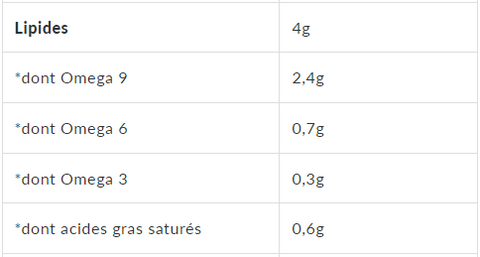Omega-3, omega-6, and omega-9 fatty acids are essential nutrients for our health, but their role and sources can sometimes be misunderstood.
In this article, we'll explore in depth the benefits of these fatty acids, the best food sources to get them, and tips for incorporating these important nutrients into your daily diet.
Omega 3: Benefits, Sources and Advice
What are the known benefits of Omega 3?
Omega-3s are essential fatty acids that offer a multitude of health benefits. They are primarily known for their ability to reduce inflammation in the body, which can help prevent chronic diseases such as heart disease, arthritis, and even certain types of cancer.
Additionally, Omega 3 plays a crucial role in brain development and function, which can improve mental health, focus, and cognitive function.
These fatty acids also benefit cardiovascular health by reducing blood triglyceride levels, lowering blood pressure and preventing blood clots.
Where are omega-3 fatty acids found ?
The best dietary sources of Omega 3 are oily fish such as salmon, mackerel, sardines, and herring. These fish contain EPA and DHA fatty acids, which are particularly beneficial for health.

Fish oils are also rich in Omega 3 and are available as supplements for those who do not consume enough oily fish in their diet.
Additionally, flax seeds, chia seeds, and walnuts are good plant sources of Omega 3, providing ALA fatty acids that can be converted to EPA and DHA in the body.

How to increase your Omega 3 intake?
To increase your omega-3 intake, you can start by including oily fish in your diet at least twice a week. Opt for wild varieties and favor healthy cooking methods like baking or grilling rather than frying.
If you're vegetarian or vegan, add flax or chia seeds to your smoothies, cereals, or salads to get a dose of Omega 3.
You can also incorporate nuts into your daily snacks or use fish oil supplements to supplement your Omega 3 intake.
Omega 6: Benefits, Sources and Advice
What are the benefits of Omega 6?
Omega-6s are also essential fatty acids that play an important role in human health. They are involved in regulating inflammation in the body, but unlike Omega-3s, excessive consumption of Omega-6s can lead to chronic inflammation and health problems.
However, in moderate amounts, Omega 6 is beneficial for cardiovascular health, skin and hair health, as well as hormonal regulation.
Where are omega 6 fatty acids found ?
The main dietary sources of Omega 6 are vegetable oils such as sunflower oil, corn oil, soybean oil, and grapeseed oil. These oils are commonly used in cooking and preparing processed foods.

Nuts and seeds, such as almonds, sunflower seeds, and pumpkin seeds, are also rich in Omega 6, as are meats and eggs.

How to balance your Omega 6 intake?
To balance your Omega 6 intake, it is important to limit the consumption of processed vegetable oils rich in Omega 6, which are often used in processed and fried foods.
Instead, opt for healthier sources of Omega 6, such as nuts and seeds, and use them sparingly in your daily diet.
Also, make sure to maintain a balance of Omega 3 and Omega 6 for optimal health.
Omega 9: Benefits, Sources and Advice
What are the benefits of Omega 9?
Omega-9s are monounsaturated fatty acids found in many heart-healthy foods, such as olive oil, avocados, and macadamia nuts.
They are known for their ability to lower LDL (bad) cholesterol and increase HDL (good) cholesterol, which can help prevent heart disease and maintain optimal cardiovascular health.
Additionally, Omega 9 has anti-inflammatory effects that may help reduce the risk of chronic diseases such as arthritis, diabetes and some forms of cancer.
Where are omega 9 fatty acids found ?
Olive oil is the primary dietary source of Omega 9, especially cold-pressed extra virgin olive oil, which is rich in oleic acid.

Avocados are also an excellent source of Omega 9, as are macadamia nuts and peanut oil.

How to integrate Omega 9 into your diet?
To incorporate Omega 9 into your diet, use extra virgin olive oil in your salad dressings and cooking. Avocados can be sliced and added to salads, sandwiches, or smoothies for a touch of creaminess and healthy nutrients.
Macadamia nuts are delicious as a snack or added to baking recipes for rich flavor and a dose of Omega 9.
By incorporating these Omega 9-rich foods into your daily diet, you can support your cardiovascular health, reduce inflammation, and promote optimal overall health.
How to combine Omega 3, 6 and 9 in your diet?
Omega 3, 6, and 9 are essential fatty acids that play important roles in human health. By understanding the benefits of these fatty acids, identifying their best food sources, and following our tips for incorporating them into your daily diet, you can support your cardiovascular health, reduce inflammation, improve your mental and cognitive health, and promote healthy skin and hair.
However, it is rare to find a food that offers a balanced and complete combination of omega 3, 6 and 9 essential fatty acids. These nutrients are often dispersed throughout a variety of foods and it can be difficult to achieve an optimal balance in our daily diet.

Shilajit stands out as a remarkable exception. This natural compound, widely used in traditional Indian medicine (Ayurveda), is a rich source of Omega 3, 6, and 9, thus offering a unique solution to meet our body's needs for essential fatty acids. Here are the analytical results of SHAMBALLA, particularly rich in Omega 3, 6, and 9, per 100g:

This data is taken from SHAMBALLA's nutritional analysis and only represents our product. You will find certificates and analyses here.
By incorporating shilajit into your diet, you will not only be able to benefit from the individual benefits of each type of Omega, but also from their synergy, helping to support optimal health and overall well-being.
Obviously, dietary supplements are no substitute for a healthy and varied diet. Get your recipes going!!!

